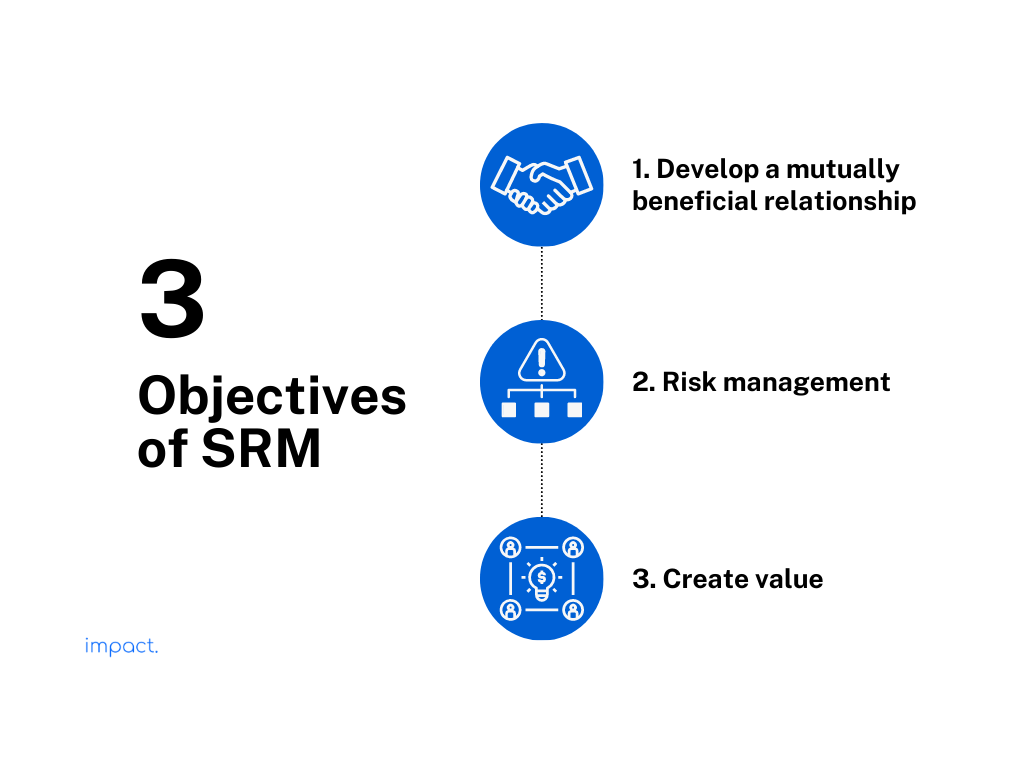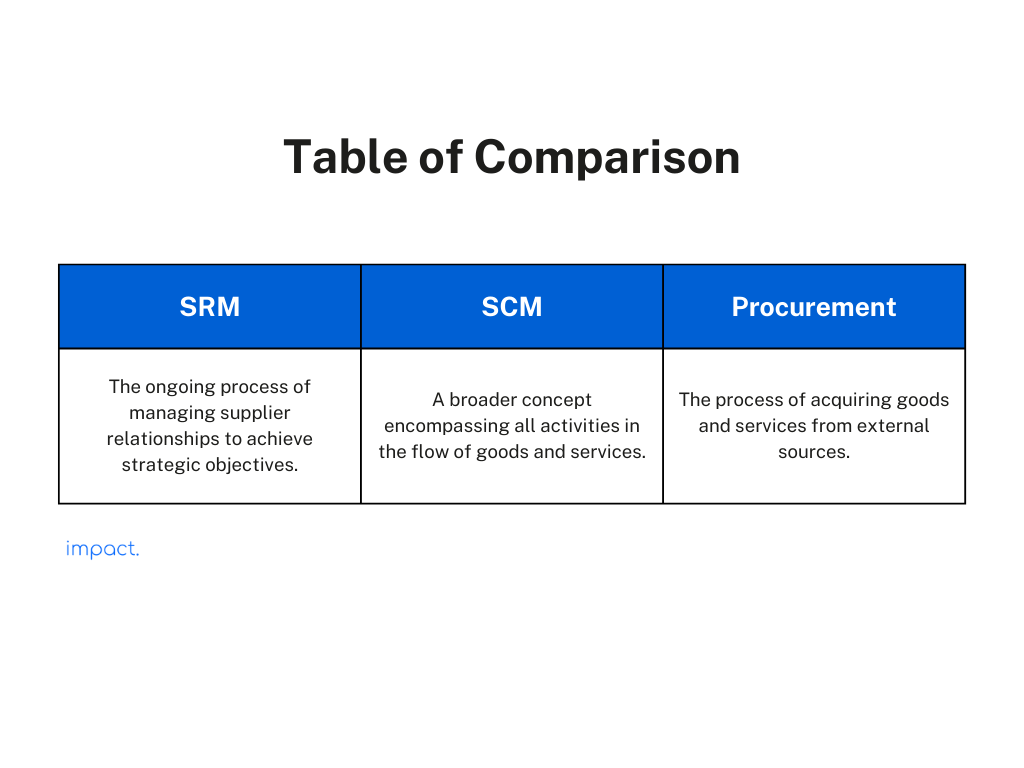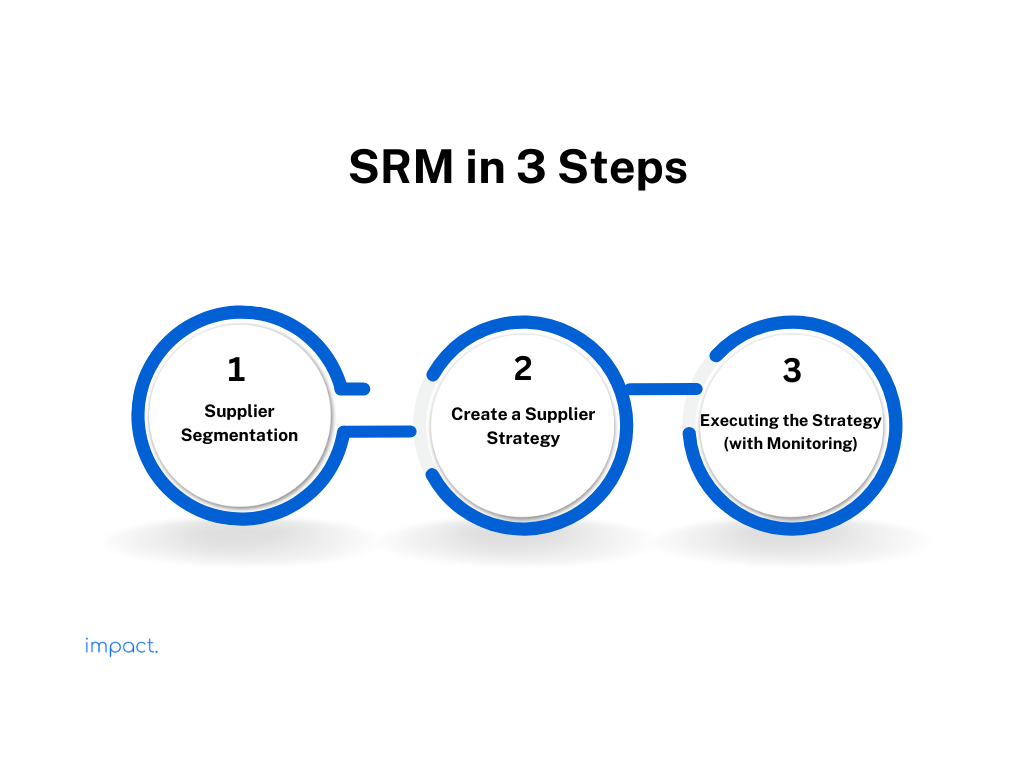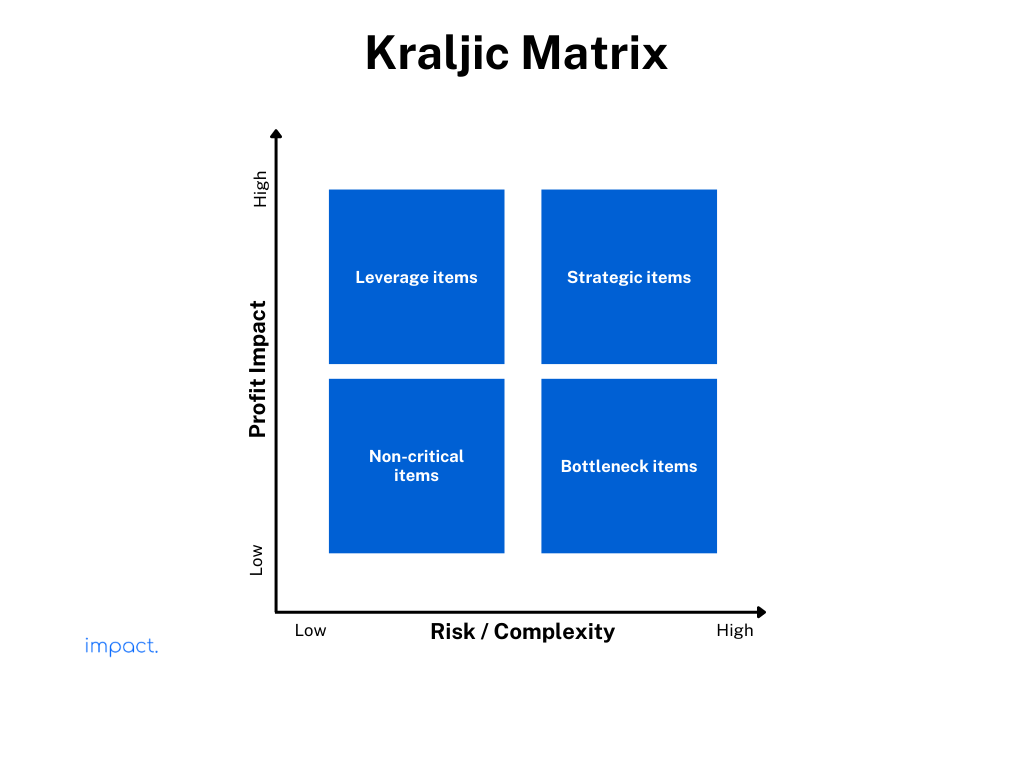Kanban: Definition, 6 Rules, and its Benefits
Kanban is a crucial part of the Just in Time (JIT) system, which we discussed…
Sean Thobias
May 17, 2025When everyone stayed at home during the 2020 lockdowns, consumer demand plummeted. The lifting of restrictions caused a dramatic surge in our need for goods.
Our suppressed consumption caused a global supply chain crisis. We managed to overwhelm logistics which resulted in mass delays and shortages worldwide. This crisis extended further to 2022 as Russia invaded parts of Ukraine.
As a result of this crisis, businesses worldwide are adopting different approaches to serve consumers better. Supplier Relationship Management (SRM) is one of those approaches.
In simple terms, SRM helps companies manage interactions with suppliers. This relationship ensures the timely delivery of goods and services while mitigating future risks.
However, if you are unfamiliar with SRM, this article will explain it comprehensively. You will also explore its importance and the steps needed to implement it successfully in your business.
Before proceeding, you need to understand the definition of a supplier. A supplier is a company that provides goods and services as part of the supply chain.
Their contribution to a specific product is fundamental, as they deliver a significant portion of its value. A supplier can manufacture their products or act as distributors who obtain from other manufacturers.
Read more: What is a supplier? Their role & 6 criteria to look out for
Supplier Relationship Management (SRM) is the ongoing assessment of a company’s suppliers of goods and services. Organizations use SRM to enhance the quality and performance of the products and services received from suppliers.
There are many reasons why a company would want to employ SRM. Here we will break it down into three objectives.

A common goal is to develop a mutually beneficial relationship with suppliers. Businesses need to determine which supplier can aid their success. Therefore, SRM helps companies manage suppliers based on a scoring system.
A large part of SRM is risk management. Businesses implement SRM to reduce disruptions in the supply chain. They work to maintain the relationship with suppliers to ensure compliance and contingency plans.
Lastly, an objective of SRM is to create value. This relationship allows businesses more significant innovation and competitive advantage than traditional purchasing methods.

SRM is not the same as supply chain management (SCM). SCM is a broader concept that incorporates all activities in the flow of goods and services. SRM, instead, is a part of SCM as it plays a crucial role in it.
You should also not confuse SRM with procurement. Procurement refers to the buying of goods and services from external sources. SRM is more strategic, while procurement only focuses on the transactional aspect of supplier management.
Businesses that utilize SRM can be ahead of the curve from their competitors. Without it, your organization could face a situation where no supplies are coming in – leading to failure.
There are multiple reasons why many companies today look toward SRM to strengthen business outcomes. The benefits of SRM include the following:
Every business wants to improve its profitability, and SRM is a solution for cost management. When you have a good relationship with suppliers, there will be opportunities to find ways to reduce costs while maintaining quality.
An effective SRM leads to better supplier performance. You will be able to collaborate and communicate with suppliers better. Suppliers will understand their expectations and get performance reviews regularly. As a result, there will be fewer disruptions, and operations will flow better.
Good supplier relationships enable both parties to share knowledge and expertise. Your organization can gain valuable insight into the latest trends within its industries.
At the same time, both businesses and suppliers can identify opportunities to enhance workflows. Ultimately, SRM assists companies in maintaining competitiveness in a dynamic market.
Partnering with suppliers for the long term provides better stability in the supply chain. Your relationship with suppliers reduces price fluctuations.
A good relationship with a supplier can help lower commodity prices through effective collaboration. This might mean considering different pricing models in exchange for other mutually beneficial agreements.
One of the main goals of SRM is risk management. When you manage supplier relationships proactively, there are fewer chances of things going wrong. You will have backup plans in place.
Also, a well-planned strategy means you will have solutions ready. So, when issues happen, you can deal with them swiftly and efficiently.
As your business builds a stronger relationship with its suppliers, opportunities may arise to outsource certain activities to them. Outsourcing could involve delegating suppliers with managing inventory and specific customer service tasks. You will be able to focus more on the business’s primary operations.
SRM can benefit many businesses, but getting it right is not easy. A Procurement Leaders study in 2017 mentioned that only 51% of collaborations are successful with an SRM program. The study identifies a lack of commitment and trust as reasons for SRM failure.
Some factors that can lead to SRM failure in an organization include:
Your business and supplier’s interests may not always be the same. Lack of alignment makes it challenging for both parties to collaborate effectively and achieve the desired benefits. Misalignment causes misunderstandings, delays, and conflicts, which can fail the SRM program.
Not correctly managing suppliers can harm your relations with them. Mismanaging suppliers can take various forms: inconsistent monitoring, having short-term focus, inflexible mindset, and lack of trust. Poorly managing suppliers can lead to quality issues and loss of business continuity.
Companies often perform SRM without understanding its purpose. Some organizations utilize SRM because of trends or perceive it as a best practice. The lack of vision toward the end goal causes SRM to fail. An effective SRM must have specific objectives that add value to its supply chain and operational strengths.
Ensuring business continuity is becoming difficult as supply chain disruptions are common. You must look beyond the immediate suppliers to anticipate these issues. Another approach is to communicate with your suppliers proactively.
Effective risk management is crucial in supplier relationship management. Failing to mitigate risks can result in financial loss, damaged reputation, legal issues, and operational disruption.

How do you start implementing an SRM program in your company? We can break down managing supplier relationships into three basic steps.
The first step is to break down your suppliers into different categories. An easy way to start is to group suppliers based on items, price, location, and quantity. By doing this, you can gain visibility across the supply chain.
There is another popular method by which you can segment suppliers further. The Kraljic Matrix allows companies to categorize purchases based on risk and importance to the business.

The matrix groups items into four quadrants:
When you divide your list of suppliers into groups that make sense, it becomes simpler to understand who they are and how to manage them well. Segmentation aids you in developing a strategy that uses your resources more efficiently.
After dividing your suppliers into groups, the next step is to formulate a strategy for managing your relationships with them. Your system should create an equally beneficial relationship with your suppliers. The plan should outline specific actions to manage and develop supplier partnerships.
In this stage, being transparent to your suppliers is crucial. Let them know your objectives, explain your business activities, and share supplier performance data. An approach like this builds trust and prevents future misunderstandings with your suppliers.
Communication with suppliers should be ongoing. When both sides are collaborative, ideas will flow. It is possible to obtain previously overlooked concepts. Furthermore, Creative proposals from suppliers can give a competitive edge.
The final step of implementing your SRM is executing your developed strategy. Acknowledging that things may not always go according to plan is essential.
However, having strong collaborative relationships with suppliers can assist in making necessary adjustments instantaneously. Effective supplier segmentation is also beneficial when prioritizing tasks in a situation that requires immediate attention.
Additionally, it is vital to monitor the performance of all suppliers consistently. Establishing Key Performance Indicators (KPIs) and success metrics is crucial for benchmarking and improving supplier performance. With KPIs, you know when to make adjustments to your strategy.
You now know how to establish an effective supplier relationship management (SRM) for your business. Here are five tips to ensure a successful SRM strategy.
Before choosing suppliers, it is crucial to understand your business requirements. You must specify your organization’s goals, recognize potential risks, and evaluate supplier capabilities. Understanding this helps you pick the right supplier that aligns with your objectives.
To have an effective SRM, you need a centralized database. This database ensures data integrity, reduces duplication, and offers real-time access to supplier information. A detailed supplier database can aid in planning, cost-saving, and maintaining supplier relationships.
SRM is building a solid relationship with suppliers. You have to treat them as partners, not vendors. Prioritizing suppliers involves focusing on their satisfaction through timely payments, clear communication, and prompt resolution of issues. It also includes collaborating with suppliers to establish mutual objectives and mitigate supply chain risks.
Providing training on the latest technologies and processes can improve your team’s competencies and overall performance. Train your team through in-house programs, relevant courses, and a positive work environment encouraging collaboration. Training enables your organization to engage with suppliers effectively, resolve issues, and fulfill contracts and agreements.
Automation simplifies SRM, enhances efficiency, and minimizes errors. Automation also guarantees that data is accurate and current. Automating data collection, analysis, and reporting allows employees to focus on more critical tasks.
One technology in mind is enterprise resource planning (ERP) solutions. Impact provides real-time actionable insights to manage supplier performance effectively. Impact ERP also aids in procurement automation, preventing inventory shortages.
Read more: What is ERP?
Companies that implement SRM have seen significant benefits. These benefits include cost savings, improved quality, and increased innovation.
Below are two prominent companies that have effectively executed SRM in their operations.
Toyota has established itself as a leader in supplier relationship management, with a reputation that few companies can match. Over several decades, Toyota has established a solid position in this area by building an enduring and collaborative partnership with its suppliers.
The automotive manufacturer lets suppliers showcase their technical capabilities in their R&D facilities. These presentations highlight innovative ideas for immediate or long-term use.
Toyota’s suppliers get rewarded for their innovations. For every helpful idea produced, suppliers receive half of the benefits earned. Toyota believes that this attracts suppliers to collaborate longer.
P&G has a history of working well with its suppliers. They view SRM as another way to extend this relationship.
P&G’s program is rigorous because they believe it will produce long-lasting results. It encourages suppliers to create value that aids P&G’s appeal and competitiveness in the market. This strategy aligns with P&G’s goal for success in the market.
Due to the size of their business, the SRM approach emphasizes risk management. P&G employs tools that give early signals regarding changes in business dynamics with suppliers. They proactively identify supply chains that pose a high risk and contingencies in case of disruptions.
As we move past the Covid-19 pandemic, business practices are altered. New trends and developments are created to improve approaches to prevent supply chain disruptions.
SRM will be a pivotal player in securing innovation in the supply base. It will act as an effective method for managing network-based suppliers and getting the most out of big companies.
Arguably, there is still little integration despite the many SRM systems available. The future of SRM will rely heavily on digital integration. Companies will use emerging Artificial Intelligence (AI) algorithms to create agile, predictive supply chains that minimize waste.
SRM is predicted to adopt blockchain technology in the future. This technology allows companies to track and prevent foul play during delivery.
Organizations practicing SRM must either develop digital skills or hire individuals who possess these skills to meet future demands. In addition to technical expertise, future practitioners must have project management, communication, and negotiation skills to collaborate with suppliers and stakeholders effectively.
Building solid relationships with customers and suppliers often serves as the foundation for business success. Companies rely on suppliers to provide the necessary resources to make and sell their products or services.
Good relationships with suppliers are essential for getting the best value for your company. When you have a good rapport with your suppliers, they are more likely to provide personalized service, discounts, and special terms. This can make your supply chain more efficient, cost-effective, and productive.
SRM is a way of actively managing relationships with suppliers to improve quality, cost, delivery, and innovation. It involves more than buying things from suppliers and includes activities such as selecting suitable suppliers, helping them improve their performance, and keeping track of how well they are doing.
To make SRM successful, the company and the supplier must work closely together, building a partnership based on trust and mutual respect. By doing this, they can help each other to succeed and improve their performance.
Impact Insight Team
Impact Insights Team is a group of professionals comprising individuals with expertise and experience in various aspects of business. Together, we are committed to providing in-depth insights and valuable understanding on a variety of business-related topics & industry trends to help companies achieve their goals.
See how our ERP provides better value.
Speak with our consultant to explore how we can improve your accounting, processes, and people.
